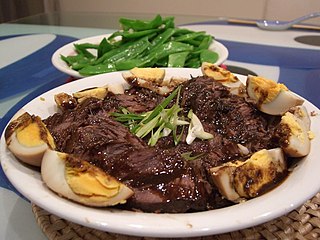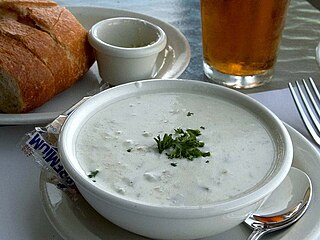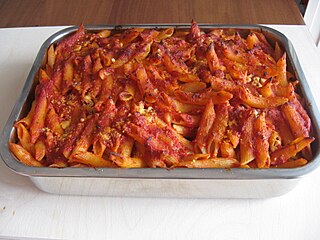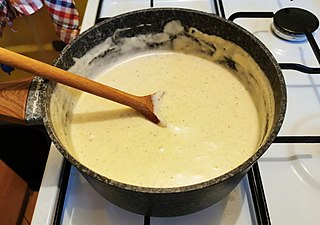
Distillation, or classical distillation, is the process of separating the components or substances from a liquid mixture by using selective boiling and condensation, usually inside an apparatus known as a still. Dry distillation is the heating of solid materials to produce gaseous products ; this may involve chemical changes such as destructive distillation or cracking. Distillation may result in essentially complete separation, or it may be a partial separation that increases the concentration of selected components; in either case, the process exploits differences in the relative volatility of the mixture's components. In industrial applications, distillation is a unit operation of practically universal importance, but is a physical separation process, not a chemical reaction. An installation used for distillation, especially of distilled beverages, is a distillery. Distillation includes the following applications:

Braising is a combination-cooking method that uses both wet and dry heats: typically, the food is first browned at a high temperature, then simmered in a covered pot in cooking liquid. It is similar to stewing, but braising is done with less liquid and usually used for larger cuts of meat. Braising of meat is often referred to as pot roasting, though some authors make a distinction between the two methods, based on whether additional liquid is added. Osso buco and coq au vin are well known braised meat dishes, and the technique can also be used to prepare fish, tempeh, tofu, or fruits and vegetables.

Poaching is a cooking technique that involves heating food submerged in a liquid, such as water, milk, stock or wine. Poaching is differentiated from the other "moist heat" cooking methods, such as simmering and boiling, in that it uses a relatively lower temperature. This temperature range makes it particularly suitable for delicate food, such as eggs, poultry, fish and fruit, which might easily fall apart or dry out using other cooking methods. Poaching is often considered a healthy cooking method because it does not use fat for cooking or flavoring the food.

In cooking, a sauce is a liquid, cream, or semi-solid food, served on or used in preparing other foods. Most sauces are not normally consumed by themselves; they add flavor, moisture, and visual appeal to a dish. Sauce is a French word taken from the Latin salsa, meaning salted. Possibly the oldest recorded European sauce is garum, the fish sauce used by the Ancient Romans, while doubanjiang, the Chinese soy bean paste is mentioned in Rites of Zhou in the 3rd century BC.

Gravy is a topping or sauce often made from the juices of meats that run naturally during cooking and often thickened with corn starch or other thickeners for added texture. The gravy may be further coloured and flavoured with gravy salt or gravy browning or ready-made cubes. Powders can be used as a substitute for natural meat or vegetable extracts. Canned and instant gravies are also available. Gravy is commonly served with roasts, meatloaf, rice, noodles, chips (fries), mashed potatoes, or biscuits.

Mirin is a type of rice wine and a common ingredient in Japanese cooking. It is similar to sake but with a lower alcohol content and higher sugar content. The sugar content is a complex carbohydrate that forms naturally during the fermentation process; no sugars are added. The alcohol content is further lowered when the liquid is heated.

Stock, sometimes called bone broth, is a savory cooking liquid that forms the basis of many dishes – particularly soups, stews, and sauces. Making stock involves simmering animal bones, meat, seafood, or vegetables in water or wine, often for an extended period. Mirepoix or other aromatics may be added for more flavor.

A velouté sauce is a savory sauce that is made from a roux and a light stock. It is one of the "mother sauces" of French cuisine listed by chef Auguste Escoffier in the early twentieth century, along with espagnole, tomato, béchamel, and mayonnaise or hollandaise. Velouté is French for 'velvety'.

The following outline is provided as an overview of and topical guide to the preparation of food:

Fricassee or fricassée is a stew made with pieces of meat that have been browned in butter then served in a sauce flavored with the cooking stock. Fricassee is usually made with chicken, veal or rabbit, with variations limited only by what ingredients the cook has at hand.

Deglazing is a cooking technique for removing and dissolving browned food residue from a pan to flavor sauces, soups, and gravies.

Fish soup is a food made by combining fish or seafood with vegetables and stock, juice, water, or another liquid. Hot soups are additionally characterized by boiling solid ingredients in liquids in a pot until the flavors are extracted, forming a broth.
Dandoy is a surname for a dynasty that cultivates the art of reduction. Notable people with the surname include:

Mushroom ketchup is a style of ketchup that is prepared with mushrooms as its primary ingredient. Originally, ketchup in the United Kingdom was prepared with mushrooms as a primary ingredient, instead of tomato, the main ingredient in contemporary preparations of ketchup. Historical preparations involved packing whole mushrooms into containers with salt. It is used as a condiment and may be used as an ingredient in the preparation of other sauces and other condiments. Several brands of mushroom ketchup were produced and marketed in the United Kingdom, some of which were exported to the United States, and some are still manufactured as a commercial product.

Pasta al forno, or timballo di pasta, is a typical dish of Italian cuisine, made of pasta covered with bechamel, tomato sauce and cheese and cooked in the oven.
Cucumber sauce is a type of sauce in English cuisine that can be made in several different varieties, both hot and cold.

In French cuisine, the mother sauces, also known as grandes sauces in French, are a group of sauces upon which many other sauces – "daughter sauces" or petites sauces – are based. Different sets and classifications of mother sauces have been proposed since at least the early 19th century.















